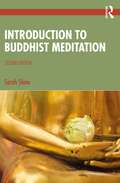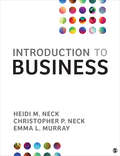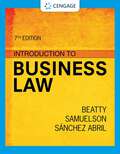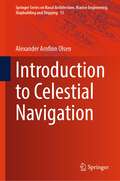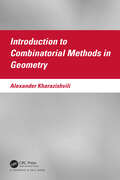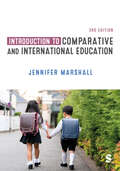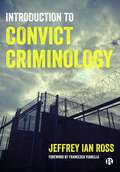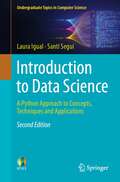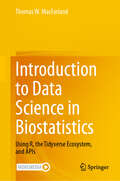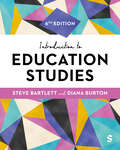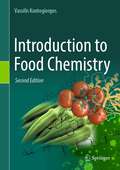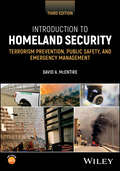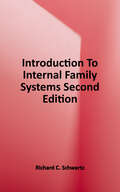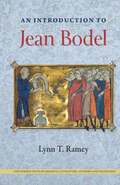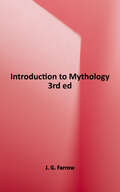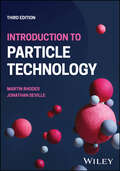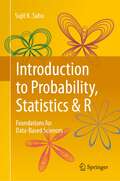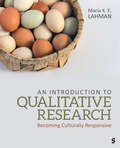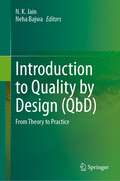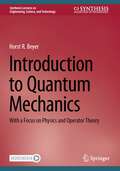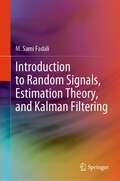- Table View
- List View
Introduction to Buddhist Meditation
by Sarah ShawThis lively introduction to Buddhist meditation offers students and practitioners alike a deeper understanding of what meditation is and its purpose and place in the context of different Buddhist schools. The historical background and geographical spread of Buddhist meditation is explored alongside an examination of the development of meditative practices. Chapters cover basic meditative practice, types of meditation, meditation in different regions, meditation and doctrine, and the role of chanting within meditation. Although not a practical guide, Introduction to Buddhist Meditation outlines the procedures associated with Buddhist practices and suggests appropriate activities, useful both for students and interested Buddhists. Vivid quotations from Buddhist texts and carefully selected photographs and diagrams help the reader engage fully with this fascinating subject.Thoroughly revised throughout, this new edition also features a glossary and key, making it ideal reading for students approaching the topic of Buddhist meditation for the first time.
Introduction to Business
by Heidi M. Neck Christopher P. Neck Emma L. MurrayIntroduction to Business ignites student engagement and prepares students for their professional journeys, regardless of their career aspirations. Best-selling authors Heidi M. Neck, Christopher P. Neck, and Emma L. Murray inspire students to see themselves in the world of business and to develop the mindset and skillset they need to succeed. A diverse set of impactful examples and cases, from inspiring startups and small businesses to powerful corporations, illustrate how businesses can prosper and create positive impact.
Introduction to Business
by Heidi M. Neck Christopher P. Neck Emma L. MurrayIntroduction to Business ignites student engagement and prepares students for their professional journeys, regardless of their career aspirations. Best-selling authors Heidi M. Neck, Christopher P. Neck, and Emma L. Murray inspire students to see themselves in the world of business and to develop the mindset and skillset they need to succeed. A diverse set of impactful examples and cases, from inspiring startups and small businesses to powerful corporations, illustrate how businesses can prosper and create positive impact.
Introduction to Business Law
by Jeffrey F. Beatty Susan S. Samuelson Patricia Sánchez AbrilDiscover the business law text you'll enjoy reading with Beatty/Samuelson/Abril's INTRODUCTION TO BUSINESS LAW, 7E. Students like you explain that this is the best text they have ever read and they had no idea law could be so interesting. This book uses conversational writing to explain complex topics and emerging legal trends in easy-to-understand language. With 75 years of combined teaching experience, these award-winning authors know how to clearly explain topics and keep your interest. Because the authors actually practiced law before they became teachers, they also describe how theories of law work in everyday business practice. This edition is packed with current examples and real-life scenarios relevant to daily life - from marijuana contracts and the research behind executive compensation to the impact of Covid-19 and #MeToo in the workplace. MindTap and Infuse digital resources help clarify concepts with interactive cases and learning tools.
Introduction to Celestial Navigation (Springer Series on Naval Architecture, Marine Engineering, Shipbuilding and Shipping #15)
by Alexander Arnfinn OlsenThis book focuses on Coastal and Ocean Navigation with an emphasis on celestial navigation techniques as a ‘back up’ in the event digital technologies fail.It deals with the main themes and principles of celestial navigation (including time). It covers the syllabus for deck officers working towards the Officer of the Watch (OOW) certificate of competence (COC) awarded by the Maritime and Coastguard Agency (MCA), and for Royal Navy navigation officers working towards achieving the equivalent Navigational Watch Certificate (NWC). The NWC is equivalent to the certificate awarded by the MCA to OOWs in the Merchant Service under the international Standardisation of Training, Certification and Watchkeeping (STCW) agreements. The detailed theory of celestial navigation is provided.
Introduction to Combinatorial Methods in Geometry
by Alexander KharazishviliThis book offers an introduction to some combinatorial (also, set-theoretical) approaches and methods in geometry of the Euclidean space Rm. The topics discussed in the manuscript are due to the field of combinatorial and convex geometry.The author’s primary intention is to discuss those themes of Euclidean geometry which might be of interest to a sufficiently wide audience of potential readers. Accordingly, the material is explained in a simple and elementary form completely accessible to the college and university students. At the same time, the author reveals profound interactions between various facts and statements from different areas of mathematics: the theory of convex sets, finite and infinite combinatorics, graph theory, measure theory, classical number theory, etc.All chapters (and also the five Appendices) end with a number of exercises. These provide the reader with some additional information about topics considered in the main text of this book. Naturally, the exercises vary in their difficulty. Among them there are almost trivial, standard, nontrivial, rather difficult, and difficult. As a rule, more difficult exercises are marked by asterisks and are provided with necessary hints.The material presented is based on the lecture course given by the author. The choice of material serves to demonstrate the unity of mathematics and variety of unexpected interrelations between distinct mathematical branches.
Introduction to Comparative and International Education
by Jennifer MarshallThis book introduces major themes surrounding comparative and international education, giving you a nuanced understanding of key debates, and thinkers, and the tools necessary to conduct comparisons using secondary sources. Social, economic, historical, and cultural factors are examined in order to investigate the varied contexts in which education takes place around the globe. This new edition includes: New case studies touching on contemporary issues from decolonising the curriculum to the impact of the Covid-19 pandemic on education A new introduction outlining the features of the book and how to use them Updated educational data from around the world and new links to external resources Dr Jennifer Marshall is Senior Lecturer in Education at the University of Derby.
Introduction to Comparative and International Education
by Jennifer MarshallThis book introduces major themes surrounding comparative and international education, giving you a nuanced understanding of key debates, and thinkers, and the tools necessary to conduct comparisons using secondary sources. Social, economic, historical, and cultural factors are examined in order to investigate the varied contexts in which education takes place around the globe. This new edition includes: New case studies touching on contemporary issues from decolonising the curriculum to the impact of the Covid-19 pandemic on education A new introduction outlining the features of the book and how to use them Updated educational data from around the world and new links to external resources Dr Jennifer Marshall is Senior Lecturer in Education at the University of Derby.
Introduction to Convict Criminology
by Jeffrey Ian RossConvict criminology (CC) is based on the belief that the convict’s voice has been traditionally ignored or marginalized in scholarship and policy debates, and that its inclusion can positively impact the fields of corrections, criminology, criminal justice, and policy making. Designed for students, scholars, and activists worldwide this is the first sole-authored book to comprehensively explain the CC approach to scholarship, teaching, mentorship, and prison and criminal justice activism. It reviews the history and scholarship on this engaging field and the challenges that the approach has encountered. It features: • exhibit boxes • keywords • test questions - including multiple choice, short answer and essay format.
Introduction to Data Science: A Python Approach to Concepts, Techniques and Applications (Undergraduate Topics in Computer Science)
by Laura Igual Santi SeguíThis accessible and classroom-tested textbook/reference presents an introduction to the fundamentals of the interdisciplinary field of data science. The coverage spans key concepts from statistics, machine/deep learning and responsible data science, useful techniques for network analysis and natural language processing, and practical applications of data science such as recommender systems or sentiment analysis. Topics and features: Provides numerous practical case studies using real-world data throughout the book Supports understanding through hands-on experience of solving data science problems using Python Describes concepts, techniques and tools for statistical analysis, machine learning, graph analysis, natural language processing, deep learning and responsible data scienceReviews a range of applications of data science, including recommender systems and sentiment analysis of text data Provides supplementary code resources and data at an associated website This practically-focused textbook provides an ideal introduction to the field for upper-tier undergraduate and beginning graduate students from computer science, mathematics, statistics, and other technical disciplines. The work is also eminently suitable for professionals on continuous education short courses, and to researchers following self-study courses.
Introduction to Data Science in Biostatistics: Using R, the Tidyverse Ecosystem, and APIs
by Thomas W. MacFarlandIntroduction to Data Science in Biostatistics: Using R, the Tidyverse Ecosystem, and APIs defines and explores the term "data science" and discusses the many professional skills and competencies affiliated with the industry. With data science being a leading indicator of interest in STEM fields, the text also investigates this ongoing growth of demand in these spaces, with the goal of providing readers who are entering the professional world with foundational knowledge of required skills, job trends, and salary expectations. The text provides a historical overview of computing and the field's progression to R as it exists today, including the multitude of packages and functions associated with both Base R and the tidyverse ecosystem. Readers will learn how to use R to work with real data, as well as how to communicate results to external stakeholders. A distinguishing feature of this text is its emphasis on the emerging use of APIs to obtain data.
Introduction to Education Studies
by Steve Bartlett Diana M BurtonIn this fully updated sixth edition of this much-loved textbook, students will be introduced to different ways of looking at education, supported by links to classic and contemporary research. Built around the essential themes of psychology, history, policy and sociology, this new edition explores a range of contemporary topics found on Education studies courses, including: UK education policy since 2020, including policy responses to the COVID-19 pandemic Decolonising the curriculum and social justice Education studies and student employability Expanded coverage of cognitive psychological theories of learning
Introduction to Education Studies
by Steve Bartlett Diana M BurtonIn this fully updated sixth edition of this much-loved textbook, students will be introduced to different ways of looking at education, supported by links to classic and contemporary research. Built around the essential themes of psychology, history, policy and sociology, this new edition explores a range of contemporary topics found on Education studies courses, including: UK education policy since 2020, including policy responses to the COVID-19 pandemic Decolonising the curriculum and social justice Education studies and student employability Expanded coverage of cognitive psychological theories of learning
Introduction to Food Chemistry
by Vassilis KontogiorgosThe complexity of food chemistry makes it a challenging subject for students studying in a food science course. Although there are excellent food chemistry books available in the market they have two major flaws: they are either encyclopedic or they are not pitched correctly to undergraduate food science students. The first problem creates difficulties for students to identify what is important and how much they need to know. The second problem arises when the book is written by authors that are not food scientists (e.g., chemists), they are not academics that are engaged with teaching or they are not sufficiently qualified to teach. In this case, it is difficult to find links between the chemistry of foods and its relevance to applications or, quite frequently, future employment prospects of the student. Introduction to Food Chemistry, 2nd Edition bridges this gap in the relevant literature, as it employs the latest pedagogical theories in textbook writing to present the subject to students with broad range of cognitive skills. This book presents specific learning objectives for each chapter and is self-contained so students will not need to search for essential information outside the textbook. This new edition has been expanded to include chapters on sweeteners, glass transition, amino acids, proteins for major food commodities and food additives. All of the original chapters have been updated and expanded to include new research and technologies. To support learning, the book has:Didactic elements with information being conveyed with 3D-figures, color-coded schemes and graphs, annotations on figures that link it to the text descriptionsBuilt-in pedagogy and learning activities at the end of each chapter that are linked to the learning objectives.Keywords and concepts for online search to instigate curiosity for further studies.Conversational writing style without losing academic rigorTo support lecturers, the book has:Helps focus teaching preparation on key aspects of food chemistry relevant to both industry and modern research.Aids the preparation of exams, assignments and other types of assessment or learning activities.For lecturers in search of a singular source to aid in their introductory food chemistry courses, look no further than this expanded new edition of Introduction to Food Chemistry.
Introduction to Homeland Security: Terrorism Prevention, Public Safety, and Emergency Management
by David A. McEntireExplore the growing concerns about security with this vital book Homeland Security has never been a more important part of the American social and political fabric. Risk assessment, attack prediction and prevention, preparedness measures, response to terrorist activity, and natural disaster management all fall under the purview of homeland security. It is a key focus of the US security state, which has expanded massively in recent decades. Introduction to Homeland Security provides an overview of this subject for professors, students, and practitioners in the field. Drawing upon a rich foundation of scholarship and academic literature, it focuses principally on terrorism prevention and protection, and offers new content related to novel threats and security concerns. Its practitioner-centered approach and attention to both governmental and non-governmental stakeholders make it an indispensable introduction to the subject. Readers will also find: Coverage of the four traditional phases of emergency management New and additional treatment of border control, drug trafficking, organized crime, mass shootings, protests, riots, pandemics, and climate change Companion websites including extensive pedagogical materials, student self-assessment tests, and an image gallery Introduction to Homeland Security is ideal for professors and students in homeland security and emergency management programs, as well as practitioners involved in this important profession.
Introduction To Internal Family Systems
by Richard C. SchwartzA highly accessible introduction to a therapeutic approach that brings our inner “parts” into harmony and allows our core Self to lead We’re all familiar with self-talk, self-doubt, and self-judgment―yet most of us still view ourselves as if we have one uniform mind. Dr. Richard Schwartz’s breakthrough was recognizing that we each contain an “internal family” of distinct parts―and that treating these parts with curiosity, respect, and empathy vastly expands our capacity to heal. Over the past two decades, Internal Family Systems (IFS) has transformed the practice of psychotherapy. With Introduction to Internal Family Systems, the creator of IFS presents the ideal layperson’s guide for understanding this empowering, effective, and non-pathologizing approach to self-discovery and healing. Here, Dr. Schwartz shares evidence, case studies, and self-care tools to help you: - Shift from the limiting “mono-mind” paradigm into an appreciation of your marvelous, multidimensional nature - Unburden your wounded parts from extreme beliefs, emotions, and addictions - Demystify the most commonly misunderstood parts―the Exiles, Managers, and Firefighters - Transform your most challenging parts from inner obstacles to invaluable allies - Embrace the existence of innate human goodness―in yourself and others - Connect with the true Self that is greater than the sum of your parts “The most wonderful discovery I have made is that as you do this work, you release, or liberate, what I call your Self or your True Self―the calm, compassionate essence of who you are,” says Dr. Schwartz. “When the Self becomes the leading intelligence in our lives, we create more harmony―both within ourselves and in our external lives.” For therapists, their clients, and anyone interested in understanding and healing themselves, here is an essential guide to a revolutionary approach to self-realization, mental wellness, and transformation.
An Introduction to Jean Bodel (New Perspectives on Medieval Literature: Authors and Traditions)
by Lynn T. RameyBringing the work of a highly influential medieval French writer to English-speaking audiences for the first time This book explores the life and works of Jean Bodel, an influential author who lived in twelfth-century Arras, France. A versatile poet, playwright, and epic writer who established new genres such as fabliaux and the mystery play, Bodel remains relatively unknown to Anglophone audiences. Lynn Ramey offers translations and summaries of works never published before in English while delving into Bodel’s historical and cultural context. After a brief introduction to the poet, Ramey highlights the stimulating and cosmopolitan environment of Arras, considering the influence of the Crusades and social movements in shaping Bodel’s works. Next, Ramey provides an extensive survey of all of Bodel’s known writing across his prolific career by genre, from his most well-known work, The Play of Saint Nicholas (Le Jeu de saint Nicolas), to his final piece, Farewell (Les Congés), which offers important insight into his diagnosis of leprosy toward the end of his life. Ramey translates several pieces including pastourelles, fabliaux, and selections from the Song of the Saxons (Chanson des Saisnes). The book also includes information on Bodel’s sources, a chronology, and a glossary. With much of the existing scholarship on Bodel only available in French, this book bridges a gap in knowledge of the poet and serves as a useful resource for both students and specialists. An Introduction to Jean Bodel allows a broader audience to engage with the writer’s wide-ranging work and contributions to literary history.A volume in the series New Perspectives on Medieval Literature: Authors and Traditions, edited by R. Barton Palmer and Tison Pugh
Introduction to Mythology: Third Edition
by J. G. FarrowThe word myth is often misunderstood, to the point that some people can even be quite offended when it is used in the “wrong” context. If the term is so sensitive, then why study it or even acknowledge the validity of such a subject as mythology in our class-rooms? When we study the subject at college or university level, there is a lot more to it than just the adventures of gods or heroes who, in many cases, are not even believed in any more, at least in a literal sense. At this level of the subject we are far more concerned with the real people who actually did (or in some cases still do) believe in the gods and heroes of the systems we will be studying in the course. We are also concerned with the critics and theorists who have been contributing to the subject over the last two centuries. We cannot understand myths fully without having in our minds a complete “tool kit” of theories and interpretations, some of which are new, others which have stood the test of time for a century or more. If you are buying this book, you are probably a serious student who wants to know more about the subject, not just get a couple more credits (though we all know what a big incentive that can be). Mythology has grown as a subject in the past century, especially in the American higher education system. This is a great contrast from European countries, where students are expected to study the original languages of the sources first (especially Latin and Greek), then get to grips with the myths when they read the works of ancient poets such as Homer, Hesiod, Vergil, and Ovid. Even in our system we cannot avoid one basic fact: the word source is the most important word in mythology. Don’t panic the sources used in this book are all translated into plain English for you. Care has been taken to keep it simple. Where there are important issues arising from the use of a particular word or name in a written source, there are footnotes to explain those issues. The shorter examples given in chapters 9 to 12 of this book are each followed by discussion questions which are designed to get you, as a beginning student of mythology, used to knowing what kind of details to look for and how to recognize structures. It helps if you know some actual history and geography, too. At no point must we ever forget that our sources were real people, living in a real place and at a real time.
Introduction to Particle Technology
by Martin J. Rhodes Jonathan SevilleINTRODUCTION TO PARTICLE TECHNOLOGY A new edition of the indispensable guide to particulates and powders Particle technology concerns the formation, processing and properties of the particles and powders which make up many of the products that surround us. Such products range from the cement and aggregate in the built environment to pharmaceuticals and processed foods. Most of the process industries involve particles, either as essential components such as catalysts or as intermediate or final products, and minerals such as the rare earths that are generally mined and processed in particulate form. Particles can have many beneficial uses but they can also cause harm in the environment and, through inhalation, to the individual. In all cases, the powder properties, particularly particle size, are crucially important. This well-known textbook, now in its 3rd edition, provides an easily-understood introduction to the underlying scientific principles of particle technology, together with examples of how these principles can be used in practical design and operation of industrial processes. Each chapter contains both worked examples and exercises for the student. Based on feedback from students and users of the earlier editions, this revised and expanded text includes introductory chapters on particles as products and on computational methods. The topics have been selected to give coverage of the broad areas of particle technology and include: Characterization (size analysis, surface area) Processing (granulation, fluidization) Particle formation (granulation, crystallisation, tableting, size reduction) Storage and transport (hopper design, pneumatic conveying, standpipes) Separation (filtration, settling, cyclones) Safety (fire and explosion hazards, health hazards) Engineering the properties of particulate systems to achieve desired product performance Discrete element modelling of particulate systems Introduction to Particle Technology, 3rd Edition is essential reading for students of chemical engineering. The text is also recommended reading for students of mechanical engineering, applied chemistry, pharmaceutics, physics, mineral processing, and metallurgy, and is an excellent source for practising engineers and scientists looking to establish a working knowledge of the subject.
Introduction to Probability, Statistics & R: Foundations for Data-Based Sciences
by Sujit K. SahuA strong grasp of elementary statistics and probability, along with basic skills in using R, is essential for various scientific disciplines reliant on data analysis. This book serves as a gateway to learning statistical methods from scratch, assuming a solid background in high school mathematics. Readers gradually progress from basic concepts to advanced statistical modelling, with examples from actuarial, biological, ecological, engineering, environmental, medicine, and social sciences highlighting the real-world relevance of the subject. An accompanying R package enables seamless practice and immediate application, making it ideal for beginners. The book comprises 19 chapters divided into five parts. Part I introduces basic statistics and the R software package, teaching readers to calculate simple statistics and create basic data graphs. Part II delves into probability concepts, including rules and conditional probability, and introduces widelyused discrete and continuous probability distributions (e.g., binomial, Poisson, normal, log-normal). It concludes with the central limit theorem and joint distributions for multiple random variables. Part III explores statistical inference, covering point and interval estimation, hypothesis testing, and Bayesian inference. This part is intentionally less technical, making it accessible to readers without an extensive mathematical background. Part IV addresses advanced probability and statistical distribution theory, assuming some familiarity with (or concurrent study of) mathematical methods like advanced calculus and linear algebra. Finally, Part V focuses on advanced statistical modelling using simple and multiple regression and analysis of variance, laying the foundation for further studies in machine learning and data science applicable to various data and decision analytics contexts. Based on years of teaching experience, this textbook includes numerousexercises and makes extensive use of R, making it ideal for year-long data science modules and courses. In addition to university courses, the book amply covers the syllabus for the Actuarial Statistics 1 examination of the Institute and Faculty of Actuaries in London. It also provides a solid foundation for postgraduate studies in statistics and probability, or a reliable reference for statistics.
An Introduction to Qualitative Research: Becoming Culturally Responsive
by Maria K. LahmanThis engaging introduction to all aspects of qualitative research challenges students to consider how their research can be culturally responsive. The first part of the book introduces the foundations including theory, ethics, and reflexivity, with an emphasis on multiple methodologies, from traditional to critical and cutting-edge. The second part covers practical guidance from writing proposals to data collection, and includes a chapter dedicated to creating a culturally responsive relationship with research participants. Finally, readers engage with how the quality of research is enhanced, how data are analyzed, and how research accounts are created and disseminated. Areas vital to the health of qualitative research are addressed including systemic racism and cultural humility, with cutting-edge suggestions offered in areas like hybrid research, harnessing technology, and use of social media. Multiple identities are centered in examples throughout including race, gender, and those who are hard to reach or seldom heard in research. Textboxes featuring scholars, student researchers, and community members invite readers into dialogue in an area that is contested, swiftly shifting, and always vibrant with potential. Resources for instructors are available on a website to accompany the book at: https://edge.sagepub.com/lahman
An Introduction to Qualitative Research: Becoming Culturally Responsive
by Maria K. LahmanThis engaging introduction to all aspects of qualitative research challenges students to consider how their research can be culturally responsive. The first part of the book introduces the foundations including theory, ethics, and reflexivity, with an emphasis on multiple methodologies, from traditional to critical and cutting-edge. The second part covers practical guidance from writing proposals to data collection, and includes a chapter dedicated to creating a culturally responsive relationship with research participants. Finally, readers engage with how the quality of research is enhanced, how data are analyzed, and how research accounts are created and disseminated. Areas vital to the health of qualitative research are addressed including systemic racism and cultural humility, with cutting-edge suggestions offered in areas like hybrid research, harnessing technology, and use of social media. Multiple identities are centered in examples throughout including race, gender, and those who are hard to reach or seldom heard in research. Textboxes featuring scholars, student researchers, and community members invite readers into dialogue in an area that is contested, swiftly shifting, and always vibrant with potential. Resources for instructors are available on a website to accompany the book at: https://edge.sagepub.com/lahman
Introduction to Quality by Design (QbD): From Theory to Practice
by N. K. Jain Neha BajwaThis book offers a comprehensive exploration of the Quality by Design (QbD) methodology, guiding readers from theory to practical application with accessible examples. It equips readers with both foundational and advanced knowledge, emphasizing the critical parameters necessary for designing pharmaceutical products that meet the highest quality standards. The book goes beyond theory to demonstrate how to effectively implement QbD principles in various aspects of pharmaceutical research and development, including analytical methods, formulation, and packaging processes. Through a step-by-step approach, it prepares researchers in pharmaceutical sciences, as well as professionals in the pharmaceutical and healthcare industries (including suppliers), to successfully integrate QbD into their work.
Introduction to Quantum Mechanics: With a Focus on Physics and Operator Theory (Synthesis Lectures on Engineering, Science, and Technology)
by Horst R. BeyerThis book presents an introduction to quantum mechanics that consistently uses the methods of operator theory, allowing readers to develop a physical understanding of quantum mechanical systems. The methods of operator theory are discussed throughout the book and presented with a mathematically rigorous approach. The author describes in detail how to use the methods of operator theory for analyzing quantum mechanical systems, starting with the definition of the involved physical operators (observables) up to the calculation of their spectra, spectral measures, and functional calculus. In addition, the book includes the construction of exponential functions of the involved Hamilton operators that solve the problem of time evolution.
Introduction to Random Signals, Estimation Theory, and Kalman Filtering
by M. Sami FadaliThis book provides first-year graduate engineering students and practicing engineers with a solid introduction to random signals and estimation. It includes a statistical background that is often omitted in other textbooks but is essential for a clear understanding of estimators and their properties. The book emphasizes applicability rather than mathematical theory. It includes many examples and exercises to demonstrate and learn the theory that makes extensive use of MATLAB and its toolboxes. Although there are several excellent books on random signals and Kalman filtering, this book fulfills the need for a book that is suitable for a single-semester course that covers both random signals and Kalman filters and is used for a two-semester course for students that need remedial background. For students interested in more advanced studies in the area, the book provides a bridge between typical undergraduate engineering education and more advanced graduate-level courses.
